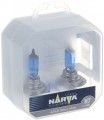Number in set
Number of lamps included in delivery.
The headlight lamps (see “Purpose”) are paired and can be supplied either
one or
two at a time - the latter is ideal if you need to install or replace both lamps at once. Also, paired configurations can be found in models for auxiliary lighting, and sometimes such lamps are supplied in
sets of 10 or even 100 pieces - this can be useful, for example, for installing side lights on a bus or truck. But the dashboard lamps are sold exclusively one at a time.
Rated power
The power normally consumed by the lamp during operation. This parameter is often used to evaluate the overall brightness of the glow, especially in the case of lamps for headlights (see "Purpose"): such a specific parameter as the luminous flux, firstly, is less familiar to ordinary car owners, and secondly, in its characteristics are not always indicated. However, it must be remembered that only lamps of the same type (see above) can be compared with each other in terms of power consumption. different types can differ markedly in efficiency and luminosity. But what this indicator directly affects is the power consumption of the lamp and, accordingly, the load experienced by the generator or battery. Modern car lamps have a power of up to 100 W, such power consumption is normally tolerated by the on-board network in normal operation. However, the lower horsepower provides some fuel savings.
Brightness
Luminous flux produced by a car lamp; for dual-mode models like bi-xenon (see “Type”), the value at maximum brightness is indicated.
This parameter characterizes the actual brightness and efficiency of the lamp; it can be used to directly evaluate and compare different models, regardless of their type and power consumption (but only at the same color temperature - see below for more details). The brightest are headlight lamps (see “Purpose”), in them this indicator can
exceed 4000 lm and vary noticeably from model to model. Therefore, when choosing such a lamp, you should pay special attention to the characteristics of the luminous flux. It should be borne in mind that too bright headlights are just as undesirable as too dim ones: high brightness creates not only the risk of dazzling for oncoming cars, but also discomfort for the driver himself. Optimal luminous flux values can be indicated in the documents for the car or for the headlight itself; if such data is not available, you can turn to other special sources.
As for other types of lamps, in models for auxiliary lighting the luminous flux is up to 800 lm, and in lamps for the instrument panel - up to 55 lm. Moreover, in both cases, the brightness is selected by the manufacturer taking into account the specific specialization and location of the lamp, so in such models this parameter is not a key one.
Increased brightness
The level of increased brightness provided by the lamp. This indicator is used by some manufacturers for marketing purposes: it describes how brighter a given model is than some "standard lamps". At the same time, the standards for comparison may be different, and impressive figures (in some models reaching 140%, that is, almost 2.5 times) are not always reliable — that is, a high-brightness lamp will not necessarily be just that much brighter than the “normal” model of the same type and power.

